

| Surveying and recording the Harvestman Platybunus pinetorum |
| .... |
|
|
For those who find Harvestmen (Opiliones) an interesting field of study, the past few years have been something of a bonus, or maybe that should be 'bunus' in view of the subject? Within the past ten years, the UK has seen four new species of Harvestmen reach these shores. The four include Leiobunum sp.A (Schönhofer & Hillen 2008, Toss 2009, Wijnhoven et al. 2007) from a Worksop garden in 2009, Platybunus pinetorum (C.L.Koch, 1839) from a Sheffield garden in 2010, Scotolemon doriae (Pavesi, 1878) from a Plymouth cemetery in December 2017 (Bilton, 2018a) and Leiobunum limbatum (L.Koch, 1861) from Colne, Lancashire in 2019. As is well known and publicised across this website, Dilys and I had recorded Leiobunum sp.A new to the UK, from the wall of a Worksop house back in 2009. |
|
| .... | ||
|
So after Paul Richards found Platybunus pinetorum in his own garden in Sheffield, Yorkshire and then a few years later started to turn up at other sites around the UK, we definitely had another species to look out for in Nottinghamshire. The
first record of
Platybunus pinetorum
for VC56 Nottinghamshire |
||
| .... |
|
Parking the car at Gleadthorpe, I began walking towards Holborn Hill Plantation, occasionally stopping to photograph the odd insect as a reminder that I'd seen it. Its a preferred practice of mine, as it just saves taking a notebook out. I then cut off the main track heading towards the plantation, but slowed to have a casual glance for anything sat sunning itself on the low foliage. As I walked I spotted a Harvestman sat on a Hogweed leaf in typical Platybunus triangularis fashion and to be honest that is exactly what I thought it was. But on close approach, I could see the distinct chestnut-coloured occularium, easily noticeable even from a metre away. Then noticing the generally darker colouration of this specimen, I knew that I had accidentally stumbled on the county's first Platybunus pinetorum. Refound in 2021 and survey results On March 21st 2021 and with the weather being fairly mild, I made a first visit of the year to Gleadthorpe and Holborn Hill Plantation areas, in the thin hope of finding P. pinetorum. The search proved unsuccessful, but a return to the area on March 30th was met with almost immediate success, finding a specimen about two feet up the trunk of a Beech and no more than 50 metres away from the location of the original record. I next visited on April 17th, with conditions pleasantly warmer and seemingly ideal. Surprisingly, the individual present on my last visit was still on the same tree and further searching revealed two more specimens on other Beech trunks nearby. All three P. pinetorum were recorded resting between two and four feet from ground level. During a follow-up visit to the site on May 4th, I initially found just the one specimen, which was the individual first found on March 30th. It was still on its favoured Beech and had now moulted to adult. There was no sign of the other two individuals found on my previous visit to the site, but conditions were windy where they had been located and I presumed too exposed and cold this time. So I decided to try another area close by, which (especially today) was considerably more sheltered. Within a minute or so, I'd found a single specimen and then four more and all on the same Sycamore. Once again, all five were situated between three and five feet from ground level. Additionally, there was another individual on a Sycamore little more than five metres away. A total of seven P. pinetorum was more than I'd ever expected on a single day. |
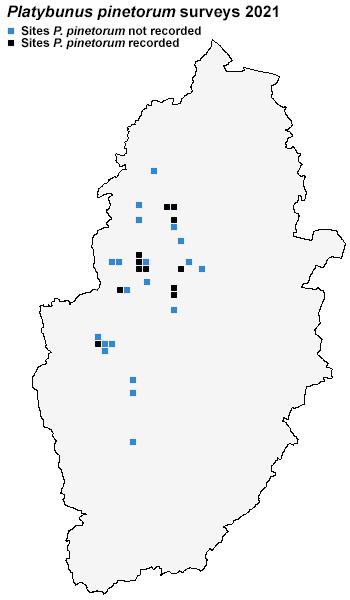 |
| .... | ||
| May 7th and I returned to Holborn Hill Plantation for yet another survey. This purpose this time, was to check which individuals (if any) were still present from May 4th and to survey the area much more extensively. In view of the future tree-felling on this site, I wanted to start and determine its range locally. | ||
| .... | ||
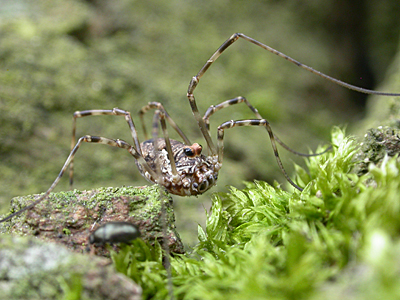 |
I walked south along the tarmac track and
away from the area of the 2020 record and
within a few minutes found my first P. pinetorum of the
day. This already meant that I'd already extended the range on site,
so now it was a case of by how much it could be extended. Another
specimen was found five feet up a Beech trunk at the top of Holborn
Hill Plantation, so I continued to follow the edge of the woodland
till I reached Hangar Hill Plantation. By this time it had become increasingly windy, due to a nearby passing shower and conditions weren't as good as they had been a few minutes earlier. But some twenty metres into Hangar Hill Plantation and I'd found another, which was moving round to find a more sheltered side of the trunk it was on. I found no more until I reached the southerly edge of Hangar Hill Plantation, and was very surprised to find three more individuals in quick succession, one of which was found feeding on the leaf mining moth Phyllonorycter maestingella. These were the last I found, although I continued to search eastwards to the edge of Budby South Forest. |
|
| With a lack of smooth barked trees to easily check, surveying was more difficult and much slower, but the targets set out at the start of surveying were more than reached during the visit. There's obviously a healthy population of Platybunus pinetorum here, but it's already under threat through loss of habitat via felling and timber extraction, with extraction being the most destructive part of the process. Should as many P. pinetorum be located to somewhere safe? Its a tempting proposition, but the big problem in Nottinghamshire, is finding anywhere that's safe for release | ||
| .... | ||
|
On May 14th I went further afield, although not setting out with the proviso of looking for Platybunus pinetorum. However, the decision was quickly determined as being a good one. I drove a couple of miles north up the A614 and decided to look at a narrow roadside plantation of Beech, Sweet Chestnut and Pine, as it was an area we had never looked at before. I was met with immediate success and within half an hour, had recorded a staggering 104 adult and near adult P. pinetorum. This was very much a minimum count, as I didn't cover the whole area and just stopped counting, as now I wanted to try other locations nearby, to determine the range here locally. All individuals as seen before, were recorded on the trunks of trees at heights between one and eight feet (just one) from ground level. Several trees had counts of five individuals and certainly three to a tree was common. I recorded very few trees without any P. pinetorum on it. As has always been the case so far, all those found have been well distanced from each other, usually well over a foot apart. Only once have I seen two individuals within touching distance and they certainly don't group in the way most Leiobunum often do. |
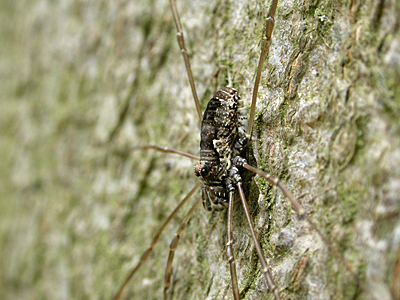 |
|
| .... | ||
|
Leaving this location, I drove north for
another mile or so and stopped to try suitable looking habitat at
Appleyhead Wood, close to the A614 and A1 junction and across the road
from the entrance to Clumber Park. After a couple of minutes searching, I'd located a single P. pinetorum about seven feet up a Beech, then went on to find a further four more. This site does hold some very old Beech with wide girths, but none were found to hold any P. pinetorum. Two days later on May 16th, I surveyed a private area of Thoresby Estate woodland containing some Beech, Pine and Sycamore, which is adjacent to a large and frequently used layby. |
|||||||||||||||||||||||||||||||||||||||||||||||||||||||||||||||||||||||||||||||||||||||||||||||||||||||||||||||||||||||||||||||
| ... | ||||||||||||||||||||||||||||||||||||||||||||||||||||||||||||||||||||||||||||||||||||||||||||||||||||||||||||||||||||||||||||||||
| This site also lies on the A614, but is situated close to a
large traffic island at Ollerton and is a few miles south of the Clumber
sites surveyed previously. Platybunus pinetorum was again
found to be present
here, with a total of 28 counted. A couple of other locations in the area were surveyed, including Boughton Brake which lies about half a mile east of the A614. No P. pinetorum were found, so I headed north up the A614 and turned left on to the A57 towards Worksop. The A57 marks the northern boundary of Clumber Park and a small strip of Sweet Chestnut woodland looked promising and eventually paid off with a single P. pinetorum despite a great deal of searching. After returning home, I made a check on two local woodland sites which seemed potentially suitable. To my surprise, four more P. pinetorum were found in Beech woodland on the A6075 Peafield Lane near Market Warsop, making this a discovery in another completely new area. |
| ... |
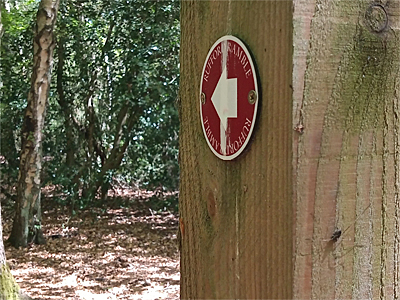 |
May 17th and 18th. So after finding P. pinetorum
well away from it's recently discovered Clumber sites, the aim now
was to try and determine the extent of its range. With the Peafield
Lane site being something of a local dumping area (in general line with most of
the county's laybys) was the county's road system a key actor in
helping P. pinetorum colonise Nottinghamshire, or had it
been here at very low population levels all along and remained
undetected? Only the former Nottinghamshire county recorder for Arachnids - Howard Williams, Dilys and myself, had done any recent Opilione recording in the county and invertebrate surveys conducted over the past 20 and 30 years had never recorded it, although no surveys had been carried out at the sites P. pinetorum has since been recorded from. So is it highly likely that it has gone undetected over the years? In Nottinghamshire, that must be considered as doubtful, as through mapping the distribution of Psychidae moths in the county, we'd spent many hours in the field (and at all of the sites on the above map) over the past 13 years, looking at tree trunks for larval cases of Psychidae moths and recording Harvestmen and other invertebrates at the same time. Certainly we'd never seen it before. |
|
| ... | ||
| But if it is as recent an
arrival into the UK as records seem to suggest it is, then the speed
of range increase is great. Nottinghamshire's woodland records seem
quite unique, as virtually all other UK records of P. pinetorum
are casual records from urban or suburban locations. But then
again, is anyone making any attempt to check woodland sites in their
county? It seems not and that may be because recorders deem it as
being a waste of time, perhaps on the basis of the largely singular, urban nature of
most county's records. So it was decided to check sites along the A614 closer to Nottingham, but suitable habitat at Gravelly Hollow near Calverton (containing Sycamore) and a small plantation of Beech on Longdale Lane near Papplewick, both proved negative. However, I eventually met with success at Rufford CP further north on the A614 and after a while searching mixed woodland at the site of the road, I finally found a single P. pinetorum at the entrance barriers. Now Rufford is less than a mile from the Ollerton site where I recorded P. pinetorum a day or so before, so it was not unexpected here. I then found an additional specimen a hundred yards away on a signpost and when I cross over the A614, I soon found it to be present at on a Sycamore at Vexation Lane. On May 23rd I tried a small area of Beech woodland lying just on the edge of the Sherwood Forest NNR, at the south-west corner of Budby South Forest and the north-west corner of the Sherwood Forest CP. Once again, most of these trees are marked for felling (presumably later in 2021) and includes some mature Beech and some younger trees. Three P. pinetorum were found in total, so another site for this most handsome and beautifully marked Harvestman. Two small groups of mature Beech covering just a few square metres within Seymour Grove (a belt of mostly Scot's Pine separating Budby South Forest from Sherwood Forest CP) were also checked. There were no further surveys until June 11th when I again returned to the Budby South Forest area. One female was soon found at SK605686, where three were found on my previous visit. Continuing on, I located another female about a hundred yards or so slightly further west and finally found another on Beech next to Thynghowe at Hangar Hill Plantation. 2021 Winter records One of the unknowns (at least personally) was the overwintering location/habitat of P. pinetorum juveniles. Within leaf litter was suspected, so in early December, I returned to the Clumber site alongside the A614. The aim was to collect some leaf litter samples to take home and sort through, but the first carrier bag full proved fruitless, but the sample did contain the Pseudoscorpion Neobisium carcinoides. I tried the same sampling method at Meden Vale on December 4th, despite there being no record of Platybunus pinetorum from the location. There were two juvenile Platybunus triangularis in that sample, but no P. pinetorum, but it was worth checking and was at least very useful in giving me an idea of what sort of size Platybunus juveniles were in early December. |
||
|
On December 7th 2021, I returned back to the Clumber site again and took another carrier bag of leaf litter home for sorting. The sample was taken from under some discarded carrier bags, half-covered with leaves. This time I was successful in finding two P. pinetorum juveniles (right) both turning up in the same handful and the mystery of overwintering location was known, though in all honesty, it wasn't any surprise. 2022 survey results and mapping On March 18th 2022 and with the temperature being mild, I went to the Clumber site along the A614 for a first survey of the year. The weather was cool and there was a fairly strong breeze, but I was hopeful that at least one Platybunus pinetorum may have made the transition from leaf litter to tree trunk. After a search of as many Beech trunks as possible within the time available, I found one juvenile/sub-adult on the trunk of a young Sycamore next to the roaD, which was already minus two legs. I returned again on April 8th and in a short search, soon found seven sat head down on the trunks of several Beech. The temperature was cool and there had been a light frost overnight, so numbers at this site should gradually build from now on. |
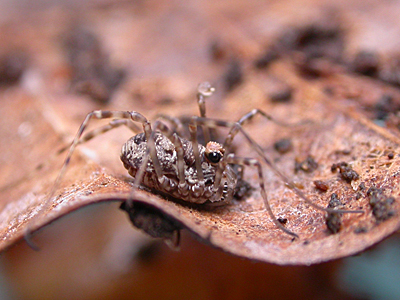 |
|
| ... | ||
| The first Platybunus pinetorum of the year at Holborn Hill Plantation, were two found low down on the Beeches on 23/04/22 and two were also reported from nearby at SK604685 and SK601682 by Nick and Samantha Brownley. | ||
|
Both these locations were close to where the species was recorded in 2021, but the grid ref of SK601682 does represent a new location. On the last day of April, I again revisited the A614 Clumber site on 30/04/22 and after expecting a high count, was somewhat disappointed to find just seven pinetorum in the northern half of the roadside woodland and concluded that peak numbers are a week or so away. | ||||||||||||||||||||||||||||||||||||||||||||||||||||||||||||||||
| ... | |||||||||||||||||||||||||||||||||||||||||||||||||||||||||||||||||
|
2023 survey results
It's now four years since Nottinghamshire saw its first record of this quite beautifully marked harvestman and it is hoped that 2023 will see extended surveying and recording to help update the current range and status of Platybunus pinetorum in the county. This of course, has to be undertaken during the Spring period, usually anytime after the middle of March and continuing into June. How late pinetorum remains active is somewhat unknown, but the latest Nottinghamshire date is currently June 11th, but the end of June are my own thoughts on what's a more likely latest possible date. Its also worth keeping an eye out for the much smaller Megabunus diadema while surveying for pinetorum. In Nottinghamshire at least, the two species seem to have very different likes as per what they deem suitable habitat, but both species share a liking for smooth-barked trees, although again, this could purely be down to ease of locating by the observer? While it is always possible that Megabunus diadema does indeed share the same tree as pinetorum somewhere, recent recording in Nottinghamshire continues to suggest otherwise and despite continued looking over a number of years now, M. diadema is still very much a harvestman of shaded, coppiced woodland, lying on heavier, clay-based soils in VC56. By now (April 5th) both large juvenile and small sub-adult pinetorum are appearing on the trunks of suitable smooth-barked trees such as Beech, where they are much easier to see. In the previous two years, it has been noted that woodland with little or no ground vegetation is preferred. There are currently no records coming from woodland where the understorey is dominated by Bramble or other thick vegetation such as Bracken, and it is only known from woodland situated on light, sandy soils. On the latest distribution map provided on the right, the vertical line of records represent this species' distribution along the A614. The most southerly record on this line is the entrance to Rufford CP and woodland directly across the road. Although it has been looked for at accessible sites further towards Nottingham, it has remained absent. The first record of 2023 came on a mild March 16th, when a juvenile was located about four feet up a Beech trunk, from woodland at the side of the A614 at Clumber Park, providing a new earliest date in the process. No purposeful further surveying was undertaken and the visit was purely to see if Platybunus pinetorum was out and on the trunks. |
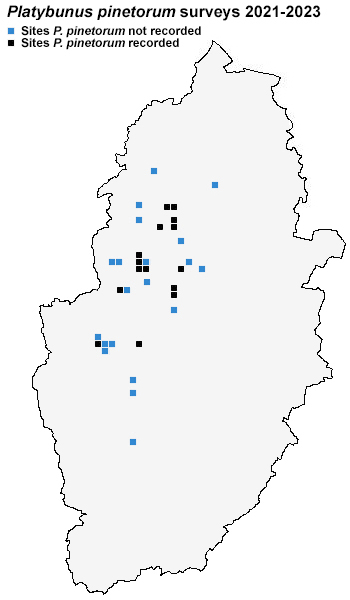 |
|
|
P. pinetorum remains at Holborn Hill Plantation, with a sub-adult found in a leaf litter sample taken from the base of several Beeches on site and six were at the A614 Clumber site on 02/04/23. Nick and Samantha Brownley recorded two pinetorum near the visitor centre at Clumber on the same date, providing a new grid square in the process. | ||||||||||||||||||||||||||||||||||||||||||||||||||||||||||||||||
| On April 15th, another new site was recorded by Nick and Samantha Brownley, this time at Rainworth Tippings Wood which is a small area of woodland bordering on to south-east Rainworth. This actually marks the joint most southerly record for Platybunus pinetorum to date, shown as the lower right-hand black grid square on the above map (updated April 15th). Surely, it has to be present nearer Nottingham in the south of the county, Newark to the east and Retford in the north-east? | |||||||||||||||||||||||||||||||||||||||||||||||||||||||||||||||||
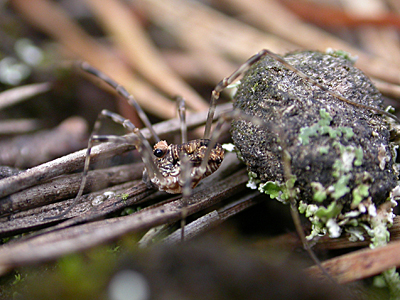 |
2024 survey results
A very early record came of a juvenile/sub-adult from the western-end of Budby South Forest on a very mild February 17th. The surprisingly early find was accidental, coming while surveying ladybirds on a number of small Scot's Pines growing in a small open area adjacent to an area of mature Pines. It also marked the first documented occurrence of Platybunus pinetorum actually being recorded on foliage in Nottinghamshire, being found sat on a Pine cone at the end of a small branch at about five feet height and only being noticed when it moved. It did drop to the ground, where it was later photographed (showed left) before being returned. This record actually put another grid square on the current distribution map (now showed) despite being in relative close proximity to two other known locations for pinetorum in the Budby South Forest and Hangar Hill/Holborn Hill areas. |
|
|
Another early count induced by the mild weather, came the day after the
Budby record from the regular Clumber Park site at the side of the A614,
when Nick and Samantha Brownley recorded at least 30 in a short
searching, noting multiple counts on a number of trees. In April, beating mostly mature Scot's Pines at the western-end of Budby South Forest, a large area of lowland heath with scattered Pines and other trees, produced a number of adult Playbunus pinetorum from the lower branches of various Pines. |
|
|||||||||||||||||||||||||||||||||||||||||||||||||||||||||||||||||||||||||||||||||||||
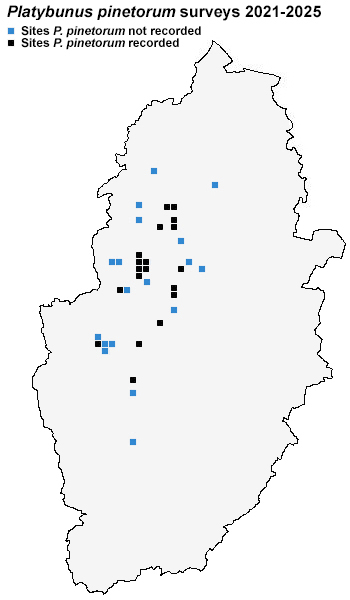 |
There were no searches of trunks, but it was thought at the
time that such searches would probably produce records. This confirmed
that the record of a juvenile recorded on a scrub Pine in February, was
certainly not a one-off occurrence and also proved that pinetorum may
have been missed at Budby South Forest for several years. Certainly, the range expansion of Platybunus pinetorum is rapidly increasing, within both the Sherwood Forest area and over a much wider part of Nottinghamshire. Evidence to support this, was the discovery of pinetorum deep in the commercial Pine plantations of Blidworth Bottoms, when four adults were beaten from both Yew and Pines by Nick and Samantha Brownley on April 27th. This takes pinetorum closer to Nottingham than previously seen, but a search of suitable deciduous habitat at Burnstump CP a week earlier, had proved fruitless. May 4th saw a new record count of Platybunus pinetorum come from the regular Clumber Park site, just opposite the Clumber Hotel. Nick and Samantha Brownley counted a total of 162 and didn't even survey the entire roadside woodland. Nick and Sam later commented that the count would no doubt have easily reached 500, had the whole area been surveyed. Later the same day, they beat a single specimen from a Yew Taxus baccata, from the Black Pool area of Sherwood Forest, which marks another new 1km grid square in pinetorum's range expansion. 2025 survey results After a cooler Winter than has been the case for a number of years, the first pinetorum appeared in woodland alongside the A614 at Clumber Park on March 19th. Other early reports include two from Nick and Samantha Brownley, of two found at one of the regular Clumber Park sites on April 15th, with five at Tippings Wood, Rainworth on April 16th and produced a welcome record from a new grid square, from woodland located off Inkersall Lane.
|
|||||||||||||||||||||||||||||||||||||||||||||||||||||||||||||||||||||||
| ... | ||||||||||||||||||||||||||||||||||||||||||||||||||||||||||||||||||||||||
| ..... | ||
| Platybunus pinetorum - A Harvestman new to Nottinghamshire | ||
| Harvestmen in Nottinghamshire | ||
| Spiders | ||
| Homepage | ||